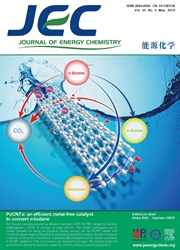

 中文摘要:
中文摘要:
Ni2P/SiO2 and bimetallic Ni MP/Si O2(M = Co, Fe, Mo, W; Ni/M atomic ratio=5) catalysts were prepared by the temperature-programmed reduction method. The catalysts and their precursors were characterized by means of UV–Vis DRS, H2-TPR, XRD, TEM, CO chemisorption and NH3-TPD. Their performance for the deoxygenation of methyl laurate was tested on a fixed-bed reactor. The results show that the main phase was Ni2 P in all catalysts, and M(M = Co, Fe, Mo, W) entered the lattice of Ni2 P forming solid solution. Different from Fe and Co, the introduction of Mo and W into Ni2P/SiO2 reduced the phosphide particle size and increased the acid amount. In the deoxygenation reaction, the turnover frequency of methyl laurate increased on the catalysts in the order of NiMoP/SiO2, Ni2P/SiO2, Ni WP/Si O2, NiFeP/SiO2 and NiCoP/SiO2, which is influenced by the size of phosphide particles and the interaction between Ni and M(M = Fe, Co, Mo or W). The introduction of the second metal(especially Mo and W) into Ni2P/SiO2 promoted the hydrodeoxygenation pathway. This is mainly attributed to the interaction between Ni and the second metal. Finally, the Ni MoP/SiO2 catalyst was tested at 340 oC, 3 MPa, methyl laurate WHSV of 14 h-1and H2/methyl laurate molar ratio of 25 for 132 h, and its deactivation took place. We found that the catalyst deactivation mainly resulted from carbonaceous deposit rather than the sintering of metal phosphide crystallites.
 英文摘要:
英文摘要:
Ni2P/SiO2 and bimetallic NiMP/SiO2 (M = Co, Fe, Mo, W; Ni/M atomic ratio=5) catalysts were prepared by the temperature-programmed reduction method. The catalysts and their precursors were characterized by means of UV-Vis DRS, H-2-TPR, XRD, TEM, CO chemisorption and NH3-TPD. Their performance for the deoxygenation of methyl laurate was tested on a fixed-bed reactor. The results show that the main phase was Ni2P in all catalysts, and M (M = Co, Fe, Mo, W) entered the lattice of Ni2P forming solid solution. Different from Fe and Co, the introduction of Mo and W into Ni2P/SiO2 reduced the phosphide particle size and increased the acid amount. In the deoxygenation reaction, the turnover frequency of methyl laurate increased on the catalysts in the order of NiMoP/SiO2, Ni2P/SiO2, NiWP/SiO2, NiFeP/SiO2 and NiCoP/SiO2, which is influenced by the size of phosphide particles and the interaction between Ni and M (M =Fe, Co, Mo or W). The introduction of the second metal (especially Mo and W) into Ni2P/SiO2 promoted the hydrodeoxygenation pathway. This is mainly attributed to the interaction between Ni and the second metal. Finally, the NiMoP/SiO2 catalyst was tested at 340 degrees C, 3 MPa, methyl laurate WHSV of 14 h(-1) and H-2/methyl laurate molar ratio of 25 for 132 h, and its deactivation took place. We found that the catalyst deactivation mainly resulted from carbonaceous deposit rather than the sintering of metal phosphide crystallites. (C) 2016 Science Press and Dalian Institute of Chemical Physics. All rights reserved.
 同期刊论文项目
同期刊论文项目
 同项目期刊论文
同项目期刊论文
 Promotion Effect of Steam Treatment on Activity of Ni2P/SiO2 for Hydrodechlorination of Chlorobenzen
Promotion Effect of Steam Treatment on Activity of Ni2P/SiO2 for Hydrodechlorination of Chlorobenzen Comparison of Ni2P/SiO2 and Ni/SiO2 for Hydrogenolysis of Glycerol: A Consideration of Factors Influ
Comparison of Ni2P/SiO2 and Ni/SiO2 for Hydrogenolysis of Glycerol: A Consideration of Factors Influ Deoxygenation of Methyl Laurate as a Model Compound to Hydrocarbons on Ni2P/SiO2, Ni2P/MCM-41, and N
Deoxygenation of Methyl Laurate as a Model Compound to Hydrocarbons on Ni2P/SiO2, Ni2P/MCM-41, and N Deoxygenation of methyl laurate as a model compound to hydrocarbons on transition metal phosphide ca
Deoxygenation of methyl laurate as a model compound to hydrocarbons on transition metal phosphide ca Promotional effect of Fe on performance of Ni/SiO2 for deoxygenation of methyl laurate as a model co
Promotional effect of Fe on performance of Ni/SiO2 for deoxygenation of methyl laurate as a model co Catalytic deoxygenation of methyl laurate as a model compound to hydrocarbons on nickel phosphide ca
Catalytic deoxygenation of methyl laurate as a model compound to hydrocarbons on nickel phosphide ca Deoxygenation of methyl laurate to hydrocarbons on silica-supported Ni-Mo phosphides: Effect of calc
Deoxygenation of methyl laurate to hydrocarbons on silica-supported Ni-Mo phosphides: Effect of calc Influence of CS2 on performance of Ni2P/SiO2 for deoxygenation of methyl laurate as a model compound
Influence of CS2 on performance of Ni2P/SiO2 for deoxygenation of methyl laurate as a model compound Influence of Ni crystallite size on deoxygenation of methyl laurate to hydrocarbons over Ni/SiO2 cat
Influence of Ni crystallite size on deoxygenation of methyl laurate to hydrocarbons over Ni/SiO2 cat A facile approach to enhancing activity of Ni2P/SiO2 catalyst for hydrodechlorination of chlorobenze
A facile approach to enhancing activity of Ni2P/SiO2 catalyst for hydrodechlorination of chlorobenze Effects of P/Ni ratio and Ni content on performance of γ-Al2O3-supported nickel phosphides for deoxy
Effects of P/Ni ratio and Ni content on performance of γ-Al2O3-supported nickel phosphides for deoxy Regulating product distribution in deoxygenation of methyl laurate on silica-supported Ni-Mo phosphi
Regulating product distribution in deoxygenation of methyl laurate on silica-supported Ni-Mo phosphi 期刊信息
期刊信息
